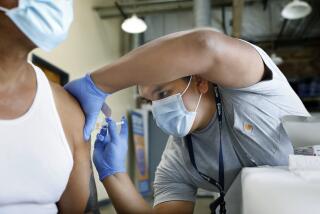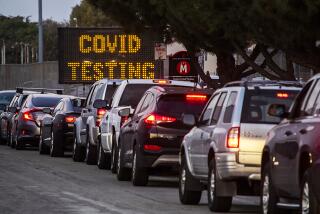Op-Ed: Pandemic fatigue has Americans glossing over Omicron. But we can’t give up

The holidays should be a time for getting together with friends and family, but instead we have a double dose of coronavirus strains — Delta and Omicron. Whether we are exhausted from the pandemic or not, we still need to prevent the spread of infections. Fortunately, we know what works.
For indoor gatherings, each person should be fully vaccinated with a booster shot, or, for someone with a confirmed prior COVID infection, at least one vaccine dose. They all should have frequent rapid antigen tests for the days prior to and time of gathering. These tests screen for whether a person is infectious, which is far more important than whether they have been infected but not capable of transmitting the virus. Ideally, all gatherings would be outdoors, but if that’s not possible, maximizing ventilation with windows open or HEPA air filtration with CO2 monitoring provides good air quality.
Unfortunately, most people won’t be willing or able to take these precautions for various reasons.
Rapid antigen tests are not widely available unless you happen to live in Colorado, where they are being distributed for free. The United States has never gotten testing on the right track since the first day of the pandemic, and that is still the case.
In Europe, more than 60 rapid tests are approved by the regulatory authorities. They are freely available in many countries or for nominal cost from vending machines or pharmacies. In the U.S. , the Food and Drug Administration has been very slow to provide clearance for the tests, with only a handful on the market (Binax is the most common). But these tests remain expensive at around $8 each, which makes frequent or daily testing much too costly for most people.
While the rapid tests are a limiting factor, using medical grade masks shouldn’t be. Both KN95 or N95 masks are widely available, inexpensive, and well worth the added layer of protection against Delta or Omicron, both of which are far more contagious than earlier variants. Yes, it’s unrealistic for people at holiday gatherings to be wearing KN95 masks, especially sharing a meal, but wearing them is still worthwhile when possible.
The greater danger is the false sense of security and complacency among the public after living with the pandemic for nearly two years. Many people, after reading early reports suggesting Omicron might be a milder form of the virus, are asking “Why should I worry?”
First, we don’t have any evidence that Omicron is milder than Delta. We know it has induced less severe illness, fewer hospitalizations and deaths. But the primary explanation for that is not the virus, it is our immunity built up from either prior infections, vaccinations, or both.
Second, you should worry because an infection can spread to infections in others, so vulnerable people such as the aged or immunocompromised can get hit. The person infected can still get quite ill with high fevers, loss of smell and taste, and other symptoms, even if there is no pneumonia or other organ injury besides the lungs. Importantly, there is the concern about long COVID, which can be an enduring, disabling complex of symptoms, including profound fatigue, breathlessness, brain fog, and other features even in people with mild infections. We don’t know yet how common long COVID will be for Omicron infections and whether vaccinations protect from this condition.
Meanwhile, the U.S. is in the midst of a second surge of Delta with over 120,000 new confirmed cases a day, more than 1,200 deaths a day, and currently with more than 66,000 patients in the hospital. Omicron is just getting started, still in single digit percentages, but will double as the cause of infections every 2-3 days. In a matter of weeks, Omicron is certain to become the dominant strain throughout the country.
With Omicron displacing Delta, we will likely see more than a million new cases a day in the United States, as projected from new records seen in Southern Africa, Britain, Denmark, Norway and other countries that have already seen a rise in Omicron.
Even if Omicron yields an overall milder picture of sickness than earlier variants, the enormous number of people infected means we will see the vulnerable — the aged, the immunocompromised, the unvaccinated, and those who have been vaccinated but whose immunity has waned — needing hospitalization and those numbers will likely be substantial. That means our medical providers and resources will likely be overrun again.
That’s why we need to plan for the worst, hope for the best. Soon we will have potent drugs to help treat infections in their early days and prevent the progression of illness, and on the horizon are prospects for a universal vaccine against all coronaviruses and protection against future variants.
But for now, we should use every tool at our disposal to limit the spread of the virus strains. Only in that way will we make progress in transitioning COVID-19 to an endemic disease from the seemingly endless pandemic we face now.
Eric J. Topol is a professor of molecular medicine at Scripps Research and author of the newsletter Ground Truths.
More to Read
A cure for the common opinion
Get thought-provoking perspectives with our weekly newsletter.
You may occasionally receive promotional content from the Los Angeles Times.






